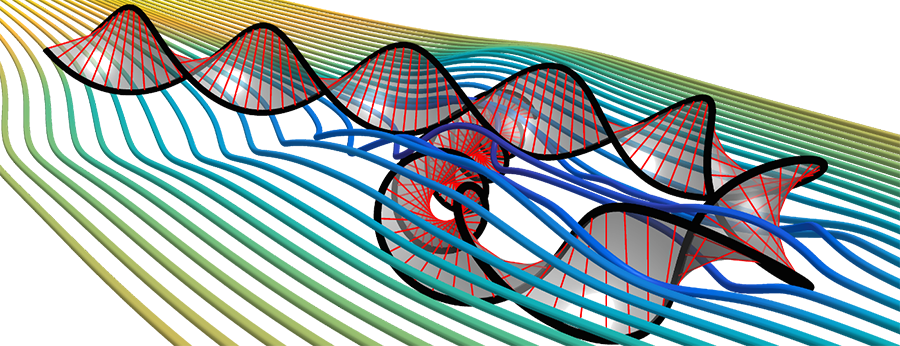Continuum mechanics, arguably the crown jewel of classical physics, deals with the kinematic and mechanical behaviour of materials modelled as a continuum. It has applications in a wide range of disciplines, including mechanical, aerospace, civil, chemical and biomedical engineering, geophysics, oceanography, meteorology, astrophysics, and biology.

The Continuum Mechanics group in Birmingham is studying various flow phenomena, in particular those related with bubbles, drops, jets, porous media, transport and mixing of pollutants and chemical reactions. These are encompassed by both curiosity and applications. We combine theoretical and numerical methods as well as experiments through collaborations to solve problems in continuum mechanics.
- The Continuum Mechanics group of Birmingham has been developed over a half of a century.
- Over the past ten years, the members of the Continuum Mechanics group have been awarded over 2 million pounds to support their research and PhD students.
- Over the past ten years, the members of the research group have published over 100 articles in influential mathematical and scientific journals.
- The group has a world-leading reputation in the mathematics of bubbles and moving contact lines (also known as the three-phase contact line).
A list of recent grants obtained by the Group can be found on the grants page. Previous PhD students in the Continuum Mechanics Group, together with their theses, can be found on the previous PhD students page.
Head of Continuum Mechanics Group
Professor
Professor Wang's current research is mainly on physical, mathematical and computational studies on bubble dynamics in compressible and viscous liquid, cavitation generation, drug delivery using microbubbles and ultrasound, ultrasound cavitation cleaning, and sonochemistry.
Academic Staff

Senior Lecturer
Dr Leppinen has extensive experience applying mathematics to examine industrial processes. He is currently studying the dynamics of free surface flows, particularly the compressible and incompressible dynamics of bubbles and droplets.

Associate Professor in Applied Mathematics
Dr Meyer's research is in the field of analysis of nonlinear differential equations and is interested in the following areas: reaction-diffusion theory, maximum principles, quasi-linear parabolic partial differential equations, chemical reaction modelling.
Professor of Applied Mathematics
Professor Shikhmurzaev researches fluid mechanics, free-boundary problems, capillary flows (dynamic wetting, fluid motion with transitions in the topology of the flow domain), singularities in the mathematical models of natural phenomena, two-phase flows in porous media, and interaction of continuous media with electromagnetic field.
Lecturer
Dr Smith researches perturbation theory, strongly nonlinear analysis and acoustic cavitation.

Associate Professor in Applied Mathematics
Dr Tzella's work studies how tracers (e.g. pollutants) evolve in idealised fluid and porous flows. This uses mathematical and computational methods to develop models that provide better descriptions and predictions of the concentrations in various situations, with emphasis on environmental issues like the distribution of plankton species in the ocean and contaminants in groundwater aquifers.
Lecturer in Applied Mathematics
Dr Uddin's primary area of interest is Fluid Mechanics and in particular the stability of flows with a free surface. He also has an interest in investigating non-Newtonian flows with applications to industry.
Research and Teaching Fellows
Research Fellow
Callan Corbett is a Research Fellow in applied mathematics.
Collaboration links include:
- School of Dentistry, University of Birmingham
- University of Oxford
- University of Cambridge
- Imperial College London
- University of Warwick
- University of Bristol
- Queen Mary University
- University of Dundee
- University of Leicester
- Indian Statistical Institute (Kolkata)
- Indian Institute of Technology Madras (Chennai)
- Moscow State University (Russia)
- Nanyang Technological University Singapore
- Dalian University of Technology, China
- Harbin Engineering University, China
- Jiangsu University of Science and Technology, China
- Shanghai Jiao Tong University, China
- Federal University of Rio de Janeiro, Brazil
- University of South Florida (USA)
- University of Minnesota (USA)
- University of Colorado, USA
- Schlumberger Cambridge Research
- US Air Force Office of Scientific Research